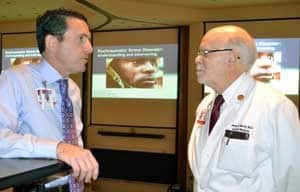Doctor Warns of PTSD Symptoms in Veterans
| Nov. 5, 2012 | “J.R.” is a 34-year-old male who recently returned from his third active-duty deployment with the Arkansas National Guard.
He’s stopped going out much because he feels on edge and is easily agitated in crowded places. He gets very little sleep at night and often awakens in a pool of sweat with his heart pounding. It has gotten so bad that his wife and boss have both encouraged him to seek help and his kids shy away from him because they’re frightened of his anger.
“J.R.” shows most of the classic symptoms of someone suffering from post-traumatic stress disorder (PTSD). And he’s not alone, as some recent studies have shown that nearly one of every six service men and women returning from deployment to Iraq or Afghanistan show symptoms of PTSD.
John Spollen, M.D., vice chair for education in the UAMS Department of Psychiatry, used the story of “J.R.” as he spoke to an auditorium full of UAMS medical residents and faculty during a special Grand Rounds hosted Oct. 25 by the UAMS College of Medicine.
“Although it’s something you don’t hear people spending a lot of time talking about, PTSD is the fifth-most common psychiatric disorder,” Spollen said. “People are coming back changed and they need our help.”
The timely topic is relevant to many UAMS faculty members and staff dealing with veterans every day.
“Our goal was to raise awareness of issues pertaining to the care of veterans and military service members in the days leading up to Veterans Day,” said Debra H. Fiser, M.D., dean of the UAMS College of Medicine. “We have a lot of faculty and residents and other staff members who work closely with veterans and we recognize the importance of this issue.”
Spollen said the rate of PTSD among the military returning from the current conflicts, at around 15 percent, is not too far off the rate of those who returned from Vietnam. The rate is significantly higher among those troops with multiple deployments. An extreme stressor or traumatic event, such as roadside bombs or sudden gunfire, is the precipitator of PTSD.
“There are three distinct types of symptoms you look for to make a diagnosis,” Spollen said. “Re-experiencing or having intrusive thoughts or images; avoidance of reminders of and thinking about the event; and some kind of hyperarousal, such as being extremely aware of their surroundings or responding to loud noises or general nervousness, those are the three to look out for.”
Spollen said treatment of PTSD is often very successful, with trauma-focused, exposure-based psychotherapy being the most effective treatment but medications, usually serotonin reuptake inhibitor medication such as sertraline, playing a large role in reducing the core symptoms, especially irritability. |
